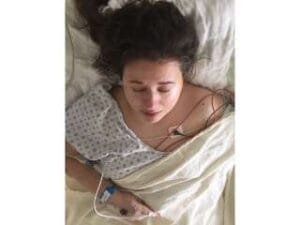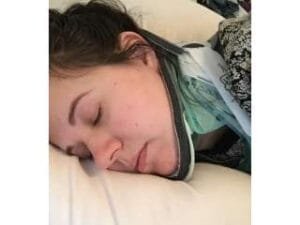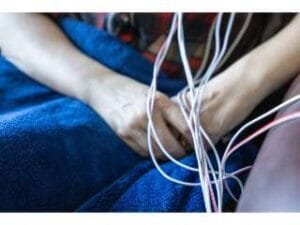The Diagnosis for an Ehlers-Danlos Journey
In this blog, we speak with Belinda, who is not only a patient living with Ehlers-Danlos Syndrome (EDS), but also Dr. Jason Addison’s wife, about how this condition has affected her life. As somebody living with EDS, her life was changed in physical, social and mental ways. From being gaslit by doctors about her condition to surviving complications after life saving surgeries, Belinda shares her story as one that is miraculous and traumatic.
The First Part
This blog is a three part series that shares various aspects of Belinda’s health journey. The first part is about her journey to a diagnosis, highlighting the impact and difficulty of an EDS diagnosis. The second part shares her journey with discovering a life changing treatment option, and what she’s doing to bring more awareness to the EDS Community. The last part of the series highlights Belinda’s mental health journey that led to her creating a community of support for many like her.
Ehlers-Danlos Syndrome
According to the Cleveland Clinic, Ehlers-Danlos Syndrome is a genetic condition that affects the connective tissue in your body, making it weaker. The connective tissue in your body is tissue that provides support throughout your body from things like tendons and joints to skin, bones and other organs. Some people living with EDS can also have potential organ involvement, some examples of this are intestinal perforation or the rupturing of blood vessels which can be unpredictable.
Experts estimate that about 1 in 5,000 people have EDS, but the true prevalence is not known and may be underestimated. EDS is very unique as it is a syndrome that can be classified into 13 different types of EDS.
This causes symptoms to be very diverse and leads to differential diagnosis by medical providers. A differential diagnosis means that a medical provider has determined that the symptoms the patient is presenting with could fall under many different conditions, and further testing is needed to confirm a diagnosis. This often makes the medical journey of people with EDS long and grueling.
A Single Moment
A single moment is all it took for Belinda’s life to change. A yawn while stretching both her arms in the air is what began her journey to a diagnosis. This single moment led to the next 12 years of Belinda’s life to be filled with multiple doctors appointments with no answers, medical gaslighting, multiple life saving surgeries, traumatic memories, and endless pain.
In 2011, Belinda was at work when she yawned while stretching both her arms above her head which caused a disc to herniate in her neck. This led to her experiencing unbearable pain to the point where she was unable to function. At this point, Belinda had no knowledge that she had spinal instability, ehlers-danlos syndrome, a tethered spinal cord or chiari malformation. The Cleveland Clinic writes that a “chiari malformation is a structural abnormality in your skull that causes part of your brain to move into your spinal canal”. EDS is a common comorbidity of Chiari Malformation.
Belinda decided to seek out treatment with a Chiropractor, but he did not do his due diligence in thoroughly evaluating her symptoms or screening for hypermobility. When he performed an adjustment, she began experiencing a multitude of neurological symptoms.
“At that moment, my Chiari Malformation became symptomatic. I lost my career, I had to raise my kids from my bed, and became immediately disabled,” says Belinda. “And on top of that, no doctors could figure out what was wrong with me.”
One of the first few doctors that Belinda made an appointment with was a top neurosurgeon in the area. This doctor proceeded to gaslight her into thinking that there was nothing wrong with her. He insisted that it was all in her head. When Belinda expressed emotions over these comments, the doctor wrongly continued to push the idea that it was depression. This was the first doctor of a long line of doctors who would proceed to gaslight Belinda.

The Journey Continues
When talking about the struggles with medical gaslighting, Belinda says one of the hardest things was what gets put on the medical record. “When one doctor tells you that it is all in your head, and puts that in your medical records, then no other doctor will believe you,” she says.
Belinda’s journey to an Ehlers-Danlos diagnosis continued. She proceeded to see over 20 doctors, who either couldn’t figure out what was wrong, didn’t know what was wrong or continued to agree that it was all in Belinda’s head. Out of desperation for answers, Belinda did her own research thoroughly examining her medical records and felt strongly that it was likely she could have Chiari Malformation. One doctor finally suggested that it could be chiari malformation, but ultimately that doctor was not equipped to perform the surgery that Belinda would need.
A Glimmer of Hope
After going so long with no answers and debilitating pain, Belinda finally had something to go on. This glimmer of hope brought her one step closer to finding an answer. When it comes to EDS, the journey is taxing on both your body and mental health, and sometimes even a small glimmer of hope can make all the difference in the journey.
“It took me 2 and a half years of being bedridden, not being able to function, dealing with debilitating pain before getting some kind of answer,” says Belinda. “I finally ended up being able to find a specialist out of state, but I couldn’t afford the surgery. At the time I was wheelchair bound and was forced to fundraise to save my own life”
After successfully fundraising, Belinda was able to afford the surgery, only for the surgery to be unsuccessful. At the time, Belinda was in multiple support groups sharing her story and finding people with similar stories. In these groups, she had some people suggesting that she may also have Ehlers-Danlos Syndrome which is common with chiari malformation and could ultimately impact the results of the surgery.
“At the time, I was just so badly off, that I didn’t have the time to investigate it, and my neurosurgeon had brushed it off, saying it wasn’t a big deal and to not worry about it,” says Belinda. “Because of that, I ended up with major complications following the surgery, including 4 severe infections.”
Ultimately Belinda had Ehlers-Danlos Syndrome, and having the surgery with this condition caused her to have additional instability in her spine. This caused her skull to slide from its original position compressing her brain stem from the opposite direction.
“I was once again in a position where I needed another life saving surgery, the infection got so bad that I had to have an emergency clean out,” says Belinda. “This led to me having a blood clot, being on IV medication for 6 weeks, having internal bleeding, having C. Diff. My body just couldn’t handle anything else.”

Finally, the Diagnosis
Belinda’s next step in her journey was to find a geneticist that could confirm her suspicions, the suspicion that not only did she have EDS, but that her family did as well. After a visit to the geneticist, It was confirmed that not only did Belinda have EDS, but her daughter and son as well. With this diagnosis, Belinda knew she would have to find a Neurosurgeon who specializes in both Ehlers-Danlos Syndrome and Chiari Malformation.
The journey to a diagnosis is such a huge part of any person with Ehlers-Danlos’ life. It is a journey filled with pain, trauma, feelings of hopelessness, isolation, gaslighting and so much more. This leads to a diagnosis being so much more than just a label. It is an answer to so many unanswered questions. It is a direction to follow leading to treatment or options. It is much more than just a diagnosis.
“After the diagnosis, I had to seek out another specialist in New York. After fundraising for the third time to save my own life, I finally had the surgery,” says Belinda. “During the surgery, he lifted my skull and screwed it into place, performing what is called a cranio-cervical fusion for cranio-cervical instability.” After two months, the specialist was also able to address the original herniated disc that was affected during the initial yawn that began this journey.
Unfortunately after this surgery, Belinda’s body had completely given out. She had gone into adrenal failure, organ failure and her digestive system had shut down. For the next 3 years, Belinda’s body would be sustained on IV nutrient therapy before she would get better.
“After being bedridden for over a decade, now I was having to learn how to walk again and working on regaining my life back and everything I had lost,” says Belinda. “If I were to use a word to describe all of it, I would say it was traumatic and miraculous.”
After finally receiving a diagnosis and having a successful surgery, Belinda’s EDS would continue to cause debilitating pain and issues in her daily life. Her next step in finding pain relief would lead her to discovering Frequency Specific Microcurrent (FSM) therapy. Frequency Specific Microcurrent therapy is a non-invasive, pain free modality that has successfully helped many EDS patients find much needed relief.

In the next part of Belinda’s story, she shares her journey with FSM and the impact that it has had on her life and her EDS journey. If you or anybody you know is experiencing EDS symptoms or has questions regarding EDS, Belinda welcomes you to join her support group. In a medical journey that can be traumatic and isolating, Belinda’s group offers support, comfort, and knowledge. Her group will help you in whatever part of your journey that you are in. Feel free to check out the support group’s facebook page as well as Belinda’s personal journey page.
Article by: Narda Sigala
Narda Sigala is a journalist and photojournalist. Narda studied at Kennesaw State University and received her Bachelor of Science in Journalism and Emerging Media with a minor in Professional Writing. She is currently pursuing a Masters in Professional Writing and will be going into the Journalism Industry. When she is not writing, she can be found at the gym. She is a nationally ranked powerlifter and competes with Cherokee Barbell
Book An Appointment Today
At Addison Chiropractic and Sports Clinic, our EDS knowledgeable chiropractors will provide screening for EDS and hypermobility. They can provide relief through innovative, non-invasive and pain free treatments. If you or anybody you know is experiencing Ehlers-Danlos Symptoms or is interested in knowing more about the treatments we offer for other chronic illnesses, either fill out the form below or give us a call at (678) 809-5773 to begin your journey to relief today.

